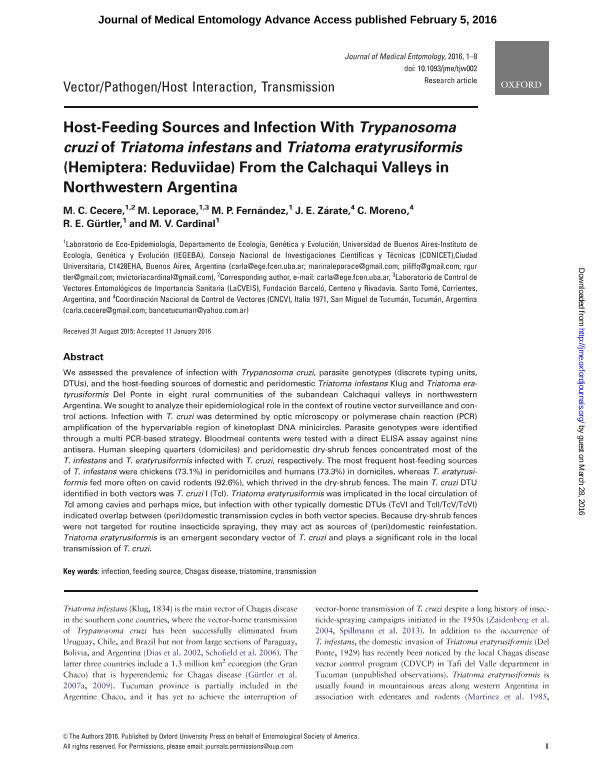Artículo
Host-Feeding Sources and Infection With Trypanosoma cruzi of Triatoma infestans and Triatoma eratyrusiformis (Hemiptera: Reduviidae) From the Calchaqui Valleys in Northwestern Argentina
Cecere, Maria Carla ; Leporace, Marina; Fernandez, Maria del Pilar
; Leporace, Marina; Fernandez, Maria del Pilar ; Zarate, Joaquín; Moreno, Claudio; Gurtler, Ricardo Esteban
; Zarate, Joaquín; Moreno, Claudio; Gurtler, Ricardo Esteban ; Cardinal, Marta Victoria
; Cardinal, Marta Victoria
 ; Leporace, Marina; Fernandez, Maria del Pilar
; Leporace, Marina; Fernandez, Maria del Pilar ; Zarate, Joaquín; Moreno, Claudio; Gurtler, Ricardo Esteban
; Zarate, Joaquín; Moreno, Claudio; Gurtler, Ricardo Esteban ; Cardinal, Marta Victoria
; Cardinal, Marta Victoria
Fecha de publicación:
01/2016
Editorial:
Entomological Society of America
Revista:
Journal of Medical Entomology
ISSN:
0022-2585
Idioma:
Inglés
Tipo de recurso:
Artículo publicado
Clasificación temática:
Resumen
We assessed the prevalence of infection with Trypanosoma cruzi , parasite genotypes (discrete typing units, DTUs), and the host-feeding sources of domestic and peridomestic Triatoma infestans Klug and Triatoma eratyrusiformis Del Ponte in eight rural communities of the subandean Calchaqui valleys in northwestern Argentina. We sought to analyze their epidemiological role in the context of routine vector surveillance and control actions. Infection with T. cruzi was determined by optic microscopy or polymerase chain reaction (PCR) amplification of the hypervariable region of kinetoplast DNA minicircles. Parasite genotypes were identified through a multi PCR-based strategy. Bloodmeal contents were tested with a direct ELISA assay against nine antisera. Human sleeping quarters (domiciles) and peridomestic dry-shrub fences concentrated most of the T. infestans and T. eratyrusiformis infected with T. cruzi , respectively. The most frequent host-feeding sources of T. infestans were chickens (73.1%) in peridomiciles and humans (73.3%) in domiciles, whereas T. eratyrusiformis fed more often on cavid rodents (92.6%), which thrived in the dry-shrub fences. The main T. cruzi DTU identified in both vectors was T. cruzi I (TcI) . Triatoma eratyrusiformis was implicated in the local circulation of T cI among cavies and perhaps mice, but infection with other typically domestic DTUs (TcVI and TcII/TcV/TcVI) indicated overlap between (peri)domestic transmission cycles in both vector species. Because dry-shrub fences were not targeted for routine insecticide spraying, they may act as sources of (peri)domestic reinfestation. Triatoma eratyrusiformis is an emergent secondary vector of T. cruzi and plays a significant role in the local transmission of T. cruzi.
Palabras clave:
Infection
,
Chagas Disease
,
Triatomine
,
Transmission
Archivos asociados
Licencia
Identificadores
Colecciones
Articulos(IEGEBA)
Articulos de INSTITUTO DE ECOLOGIA, GENETICA Y EVOLUCION DE BS. AS
Articulos de INSTITUTO DE ECOLOGIA, GENETICA Y EVOLUCION DE BS. AS
Citación
Cecere, Maria Carla; Leporace, Marina; Fernandez, Maria del Pilar; Zarate, Joaquín; Moreno, Claudio; et al.; Host-Feeding Sources and Infection With Trypanosoma cruzi of Triatoma infestans and Triatoma eratyrusiformis (Hemiptera: Reduviidae) From the Calchaqui Valleys in Northwestern Argentina; Entomological Society of America; Journal of Medical Entomology; 53; 3; 1-2016; 1-8
Compartir
Altmétricas



